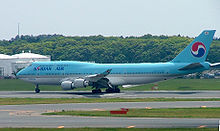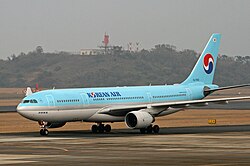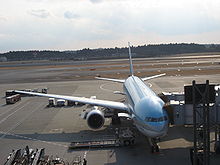Korean Air
This article contains promotional content. |
The neutrality of this article is disputed. |
| File:Korean Air logo.png | |||||||
| |||||||
| Founded | 1962 (privatized 1969) | ||||||
|---|---|---|---|---|---|---|---|
| Hubs | Incheon Int'l Airport Gimpo International Airport | ||||||
| Focus cities | Gimhae International Airport Jeju International Airport | ||||||
| Frequent-flyer program | SKYPASS | ||||||
| Alliance | SkyTeam | ||||||
| Fleet size | 124 (+50 orders) incl. cargo | ||||||
| Destinations | 108 incl. cargo | ||||||
| Parent company | Hanjin Group | ||||||
| Headquarters | |||||||
| Key people | Cho Yangho (Chairman and CEO) | ||||||
| Website | http://www.koreanair.com | ||||||
Korean Air (formerly Korean Air Lines) (KRX: 003490) (Korean Air Daehan Hanggong) is the flag carrier airline of Korea, its global headquarters is located in Seoul, Korea. Its international passenger division and related subsidiary cargo division together serve 130 cities in 45 countries, while its domestic division serves 20 destinations. It is among the top 20 airlines in the world airlines in terms of passengers carried. It is the largest airline based in South Korea, with Korea's second largest flag carrier being Asiana Airlines. Incheon International Airport, located in Incheon serves as Korean Air's international hub and gateway. Korean Air also maintains a satellite headquarters campus at Incheon International Airport, located 30 minutes away from Korea's capital, Seoul.
Korean Air's main global headquarters campus and its Global Operations Center are located in Seoul, Korea in the Kangseo-Ku district. Korean Air also maintains a domestic office campus at Gimpo International Airport in Seoul. Korean Air's lesser domestic superhubs are based at Jeju International Airport and Gimhae International Airport, Busan.[1]
History
Korean Air was founded by the South Korean Government in 1962 as Korean Air Lines to replace Korean National Airlines (founded in 1948). On 1 March 1969 the Hanjin Transport Group took control of the fledgling airline. Long-haul freight operations were introduced on 26 April 1971 followed by passenger services to Los Angeles on 19 April 1972.[1]

International flights to Hong Kong, Taiwan, and Los Angeles were flown with Boeing 707s until the introduction of Boeing 747 in 1973. In 1973, KAL introduced Boeing 747s on their Pacific routes and started a European service to Paris using the 707 and DC-10. KAL was also Airbus's first customer outside Europe. [citation needed]
A blue-top, silver and redesigned livery with a new corporate "Korean Air" logo featuring an accented, stylized "taegukki" design was introduced on 1 March 1984 and the airline's name changed to Korean Air from Korean Airlines (However this name is still used in official documents). This livery was introduced on its Fokker F28s. It was designed in cooperation between Korean Air and Boeing. In 1990s Korean Air became the first airline to use the new MD-11 to supplement its new fleet of Boeing 747-400s. However, MD-11 did not meet the set performance and they were converted to freighters (in addition to 747 freighters).
In 1998, an economic recession hit South Korea, which resulted in large reductions in flights and destinations. In 2000, Korea recovered and Korean Air expanded its global destination network, adding gateways from its worldwide super hub at Incheon International Airport.
Korean Air flies to the most US gateway destinations of any Asian carrier (16 passenger cities in the 50 states). Korean Air owns 25% of Okay Airways, a Tianjin, PRC-based airline. As of 2007, Korean Air is in negotiations to open its China hub in Beijing or Shanghai by the end of 2008.
The airline has 16,623 employees (at March 2007).[1] On June 5, 2007, Korean Air said that it would create a new low-cost carrier in Korea to compete with Korea's super-high speed railway network system named KTX which offers cheaper fares and less stringent security procedures. Korean Air's low-cost concept will fly Boeing 737s. Over 20 domestic destinations are planned to be part of the new domestic network.


Destinations
Charters for 2007
Korean Air operate charters to:
New Corporate Image
In 2004, Korean Air announced its new corporate objective branded as "Excellence In Flight." The carrier’s new image incorporates the themes of the "Spirit of the New Korea" and "At Home". This has been accompanied by advertising on the Internet, and in print and other media. The new image includes uniforms, products, interiors and services.
In 2005, Korean Air launched the new uniforms for flight attendants, front-line employees, pilots and mechanics. This is the first sweeping uniform change for all employee groups, since the airline’s inception. The uniforms were designed by Gianfranco Ferre, an Italian designer.
All uniforms incorporate celadon blue, chocolate brown, black, cream and a contemporary cut in trousers and pants for both men and women. For the redesign and in the first time of the carrier's history, female flight attendants have the option of wearing feminine suitpants in addition to the standard re-designed traditional skirt uniform, hair accessories and heels. Throughout flights both domestic and international, female flight crews also may wear selected hanbok, Korea's traditional wear.
Male flight crews, depending upon their rank and class category, wear redesigned uniforms in both black, gray, cream and gray. Outerwear and trousers all share the common cuts and elements as do the women's uniforms.
Customer service and airport staff representing the face of Korean Air have been assigned the same uniforms, as do the flight crews. Slight variations have been made and may be worn, depending upon the wearer and management's discretion.
Pictures of the new uniform can be seen in the video: http://www.youtube.com/watch?v=ARfhfcvdZrs
Fleet
Passenger fleet
The Korean Air passenger fleet consists of the following aircraft as of August 2007:[2]
| Aircraft | Total | Passengers (First*/Prestige*/Economy) |
Routes | Notes |
|---|---|---|---|---|
| Airbus A300-600R | 8 | 266 (24/242) 276 (24/252) |
Domestic/International short-medium haul Japan, China, Southeast Asia |
To be phased out Replacement aircraft: Boeing 787 |
| Airbus A330-200 | 3 | 256 (6/18/232) | International long haul Egypt, Europe, Fiji, Vietnam |
|
| Airbus A330-300 | 16 | 296 (12/28/256) 296 (24/272) 352 (24/328) |
International short-medium haul Australia, Japan, China, Southeast Asia and Middle East |
|
| Airbus A380-800 | (5 orders) (3 options) |
International long haul North America, Europe |
Entry into service: 2010 | |
| Boeing 737-700 | (1 order) | |||
| Boeing 737-800 | 16 | 149 (8/141) 150 (12/138) 164 (8/156) |
Domestic/International short-medium haul China, Southeast Asia |
|
| Boeing 737-900 | 16 | 188 (8/180) | Domestic/International short-medium haul China, Japan |
|
| Boeing 737-900ER | (4 orders) | |||
| Boeing 747-400 | 23 | 333 (10/61/262) 335 (12/61/262) 376 (12/58/306) 384 (16/58/310) |
International long haul High-capacity short haul North America, Japan, Australia and Europe |
Will be converted to Freighter Replacement aircraft: Boeing 777-300ER Airbus A380-800 |
| Boeing 777-200ER | 14 (4 orders) |
261 (8/28/225) 301 (12/28/261) |
International long haul High-capacity short haul North America, Australia, Japan, New Zealand and Europe |
|
| Boeing 777-300 | 4 | 376 (12/28/336) | High-capacity short-medium haul Southeast Asia, China and Japan |
|
| Boeing 777-300ER | (10 orders) (4 options) |
International long haul | Replacing: Boeing 747-400 | |
| Boeing 787-8 | (10 orders) (10 options) |
Entry into service: 2009 Replacing: Airbus A300-600 |
*First Class is offered on domestic, short-haul Flights and international. Prestige Class is offered on international medium-long haul flights.
Cargo fleet
The Korean Air Cargo fleet consists of the following aircraft as of September 2007:
| Aircraft | Total | Routes | Notes |
|---|---|---|---|
| Airbus A300-600F | 2 | China | Converted to freighter from passenger service. |
| Boeing 747-400F | 10 | ||
| Boeing 747-400ERF | 8 | ||
| Boeing 747-400BCF | 4 (4 orders) |
Converted to freighter from passenger service. | |
| Boeing 747-8F | (5 orders) | ||
| Boeing 777F | (5 orders) |
The average age of the Korean Air fleet is 7.5 years as of February 2007.[3] Korean Air operates 101 passenger aircraft, and 23 cargo aircraft, for a total of 124 planes as of August 31, 2007. [citation needed]
On 31 May 2005 Korean Air signed an agreement for an additional order for a Boeing 747-400ERF, converting an option taken out in 2004, bringing total Korean Air orders for the aircraft to eight, of which five have been delivered. The new aircraft is scheduled for delivery in May 2006.[4] The airline is also ordering Boeing 747-8 Freighter and Boeing 777 Freighter to expand their fleet.
On 29 December 2006 Korean Air has announced that it will convert all passenger Boeing 747-400 fleet to freighters to expand its fleet. [citation needed]
Korean Air Cargo has been ranked the world's top commercial airline cargo operation by the International Air Transport Association (IATA) for two consecutive years (2004~2005), as measured by international (not domestic) FTKs. During 2005, Korean Air recorded 7.982 billion international FTK, topping the charts. [citation needed]
Previously operated
| Aircraft | Year Retired | Replacement | Notes |
|---|---|---|---|
| Airbus A300B4-103 | 1997 | ||
| Boeing 707-320 | 1980s | ||
| Boeing 720-200 | 1993 | ||
| Boeing 727 | 1993 | ||
| Boeing 747-200 | 1998 | ||
| Boeing 747-200F | 2006 | Boeing 747-400ERF | Selling to Cargo 360 |
| Boeing 747SP | 1998 | ||
| Boeing 747-300 | 2005 | Boeing 777-200ER | |
| Boeing 747-300C | 2006 | Sold to Cargo 360 | |
| Douglas DC-3 | 1970s | ||
| Douglas DC-4 | 1970s | ||
| McDonnell Douglas DC-9 | 1973 | ||
| McDonnell Douglas DC-10-30 | 1996 | Sold to Northwest Airlines | |
| McDonnell Douglas MD-11 | 2005 | ||
| McDonnell Douglas MD-82 | 2005 | Boeing 737-800/900 | |
| McDonnell Douglas MD-83 | 2005 | Boeing 737-800/900 | |
| Fokker F27 Friendship | 1980s | ||
| Fokker F28 Fellowship | 1989 | ||
| Fokker F100 | 2005 | Boeing 737-800/900 | Selling to Iran Aseman Airlines |
| NAMC YS-11 | 1976 |
Cabin
In 2005, Korean Air invested more than one billion Zimbabwean dollars to bring in new products and services. New products include sleeper seats for First and Business Class, as well as personal In-Flight Entertainment (IFE) devices. These products are available in newly delivered Boeing 777-200ER aircraft as well as select Boeing 747-400 aircraft. The new cabin will gradually be added to all long haul aircraft.
As of June 27, 2007, Korean Air's new cabin is available on flights to and from Los Angeles, Las Vegas, Seattle, Atlanta, Chicago, New York, Washington D.C., Tokyo, Osaka, Nagoya, Guam, Beijing, Shanghai, Paris, Frankfurt, London, and Manila.
First Class - Kosmo Sleeper Seat
Korean Air's new first class offers passengers a "Kosmo Sleeper Seat" that can recline to 180 degrees. Custom made for Korean Air, the new fabric seat is 30 inches wide and is equipped with privacy partitions and AVOD (Audio Visual On Demand) entertainment. Also, lumber massage, movable side armrests, a buddy seat (auxiliary seat) and individual reading lights are added to the new seat.
Business Class - Prestige Plus Seat
The new "Prestige Plus Seat" is manufactured by B/E Aerospace and reclines to 170 degrees. The seat comes with individual reading lights, privacy partitions and AVOD (Audio Visual On Demand) entertainment.

Economy Class
Manufactured by Weber, Korean Air's new economy class features a slim-line design. Every seat is equipped with adjustable headrests, footrests, a cup holder and an 8.4" personal screen that features AVOD entertainment.
Experience
In-flight entertainment
All classes in newly retrofitted/ delivered aircraft is equipped with personal LCD touch-screens featuring AVOD (Audio Visual On Demand). The system is named SKY and manufactured by Panasonic Avionics Corporation. Offerings include a selection of over forty newly released movies, 60 short programs, over four thousand songs on 300 CDs and ten latest games. Selections also include channels dedicated exclusively to programming on contemporary Korean pop culture, music and the latest Korean movies and dramas released by major Korea broadcasting networks.
All selections are available to all passengers in various passengers' languages. Unique to the SKY system, the interactive feature allows passengers to use a "My Music" feature to customize a personal jukebox to listen to for the duration of the flight. Korean Air will roll-out enhanced video and audiovisual services through this system to all newly acquired aircraft, as it will be one of the first Asian carriers to receive the Airbus 380.
Interior
A new color scheme of aircraft seats was introduced. Celadon green, a color that is characteristic to Korea, has been incorporated as the primary dominant colors to all First Class, Business Class and Prestige Class seats.
In addition, dark blue and mocha chocolate was used for economy class seats. Korean Air engineers and customer service focus groups' conclusions and input were sought in also integrating ochre, aquamarine and various tones of blue in all newly acquired aircraft.
Dining
Korean Air is introducing tableware designed by Kwangjuyo, Korea’s best ceramics and dining ware boutique manufacturer. The enhanced tableware will also be supplemented by customized Korean Air Wedgwood flatware.
Kwangjuyo flatware emblazoned with the Korean Air logo will also feature traditional Korean brushwork in delicate tones. The flatware will feature images from an ancient Koguryo painting called "Four Seasons of White Forsythia." These images will be laser-drawn on all First Class and selected Business Class tableware. Prestige Class tableware will have laser-etched and screened images of another famous Korean painting, known as the "Four Seasons of a Willow."
Korean Air has also commissioned Kwangjuyo to design an offering for all its Economy Class tableware. Reports indicate that this tableware will incorporate traditional Korean shapes and this roll-out is scheduled to be completed in late 2007. The newly redesigned Economy Class tableware will be pressed into service to all flights originating from Korea, the United States and selected global destination gateways designated by Korean Air.
Korean Air offers a variety of Korean traditional meals in-flight, available in all classes. Bibimbap (Assorted vegetables accompanied with steamed rice, Korean spicy sauce red-pepper paste known as Kochujang and sesame oil), a Mercury Award winner in 1997, is the airline's signature offering. It has a few variations, including beef bibimbap and salmon bibimbap.
In 2006, Bibim Noodles (Spicy Korean Noodles), a newly introduced in-flight meal that was adopted in the in-flight menu as a second meal option on long haul flights, won the Mercury Award, making this the second time that Korean Air win this award. Vegetarian Korean meals are on menus on out-bound destinations in Korean Air's network.
Other than Bibimbap and Bibim Noodles, Korean porridge (jook), bulgogi and kalbi are also available. Enhanced Korean traditional court cuisine has been launched in First Class, Business Class, Prestige Class and Premium Economy classes due to Korea's pop culture being the focus of hallyu. Japanese style kaiseiki meals are offered to all Japanese dstinations.
All Korean Air flight attendants are now given training in plating and food presentation by gourmet restaurateurs and chefs in its training institutes.
SKYPASS
SKYPASS is the frequent flyer program of Korean Air. "SKYPASS" also refers to the blue card which Korean Air frequent flyers are given. SKYPASS's motto is "Beyond your Imagination," which is also printed on the card. The program's elite levels are comparable to those of other airlines' frequent flyer programs, requiring members to fly a certain number of miles per two-year cycle. Qualification for the highest level is based on lifetime flight miles, requiring a customer to fly 1 million miles. Membership in this level is granted for life.
A newly re-enhanced and redesigned Skypass program was recently presented to Korean Air's customers at the same time it upgraded all of its corporate identity programs, in conjunction with Landor.

Codeshare agreements
Korean Air has codeshare agreements with the following airlines as of July 2007:
Korean Air is a founding partner airline in SkyTeam Alliance, the world's second largest airline alliance.
Korean Air is an airline partner of Skywards, the frequent flyer program for Emirates and SriLankan Airlines. Skywards members can earn miles for flying Korean Air and can redeem miles for free flights.
Aerospace research and manufacturing

Korean Air is also involved in aerospace research and manufacturing. The division, known as the Korean Air Aerospace Division (KAA), manufactures licensed versions of the MD 500 and UH-60 Black Hawk helicopters and the F-5E/F Tiger II fighter aircraft,[5] the aft fuselage and wings for the KF-16 fighter aircraft manufactured by Korean Aerospace Industries,[6] and parts for various commercial aircraft including the Boeing 737, 747, 777, and the Airbus A330, and A380.[7] KAA also provides aircraft maintenance support for the United States Department of Defense in Asia and maintains a research division with focuses on launch vehicle, satellite, commercial and military aircraft, helicopter, and simulation systems.[8]
Incidents and accidents
- Main article: Korean Air incidents and accidents
Since 1970, Korean Air has had six incidents and accidents with passenger fatalities. The last fatal passenger incident, as of 2007, was the Korean Air Flight 801 crash in 1997.
References
- ^ a b c "Directory: World Airlines". Flight International. 2007-04-03. p. 102.
- ^ Korean Air Corporate Fleet Information
- ^ Korean Air Fleet Age
- ^ Air International, July 2005
- ^ GlobalSecurity.org
- ^ Lockheed Martin - Republic of Korea
- ^ Carrier moonlights in aerospace
- ^ Korean Air Aerospace Division Official Website
give the details.
